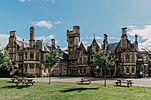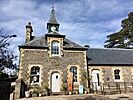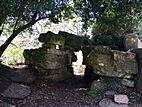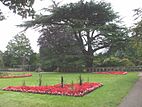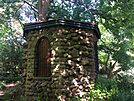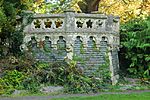Insole Court facts for kids
Quick facts for kids Insole Court |
|
|---|---|
 |
|
|
Listed buildings within Insole Court
Insole Court (Grade II*)
Stable Block (Grade II)
Rock Arch (Grade II)
Ornamental gardens (Grade II*)
Garden House (Grade II)
Terrace Wall (Grade II)
|
|
| Former names | Ely Court, The Court, Llandaff Court |
| General information | |
| Architectural style | Gothic revival |
| Location | Llandaff |
| Town or city | Cardiff |
| Country | Wales |
| Opened | 1856 |
| Cost | £10,000 |
| Client | James Harvey Insole |
| Owner | Cardiff Council |
| Technical details | |
| Floor count | 4 (3 + basement) |
| Renovating team | |
| Architect | W G & E Habershon (1855) George Robinson (1873) Edwin Seward (1875) |
| Other information | |
| Parking | Free onsite parking |
| Official name | Insole Court |
| Designated | 1 February 2022 |
| Reference no. | PGW(Gm)27(CDF) |
| Listing | Grade II* |
|
Listed Building – Grade II*
|
|
| Official name | Insole Court |
| Designated | 26 March 1976 |
| Reference no. | 14127 |
Insole Court (Welsh: Cwrt Insole) is a beautiful old mansion in Llandaff, Cardiff, Wales. It was built way back in 1855 for a rich businessman named James Harvey Insole. The building has a special Victorian Gothic style, which means it looks a bit like old castles and churches. It's so important that it's a Grade II* Listed building.
Today, Insole Court is looked after by a charity called the Insole Court Trust. They started managing the site in 2016. After a lot of work to fix it up, the ground floor of the mansion opened to the public in September 2017. Then, in 2018, the first floor opened for the very first time. It has an exhibition called 'This House is a Stage' that tells the amazing story of the Insole family.
You can visit Insole Court for free any day. It hosts many daily classes and activities, and there's even a lovely café called The Potting Shed Café. You can also rent rooms there for events.
Contents
The Insole Family Story
The Insole family lived at Insole Court from 1856 until 1938. They were very wealthy because they owned many coal mines across South Wales. They were also involved in building the Barry Railway Company and the docks where coal was shipped.
How the Family Grew Rich
As the family became more successful, they bought a lot of land. This included a large area in the ancient city of Llandaff, between the roads leading to Fairwater and Ely. This is where they decided to build their grand home.
Building Insole Court
The original house was designed by architects W G & E Habershon and built in 1855. James Harvey Insole first asked for a simple, double-fronted house, which he called Ely Court. A small lodge was also built on Fairwater Road for the family's coachman.
How the Mansion Changed Over Time
As the Insole family's wealth grew, just like the city of Cardiff itself, the house became much bigger. In the 1870s, James Harvey hired new architects, George Robinson and Edwin Seward. They changed the house to look more like the Gothic Revival architecture style. This style was popular at the time and was used by famous architects like William Burges at Cardiff Castle.
In 1874, a new tower was added to Insole Court. It looked a lot like the clock tower Burges had added to Cardiff Castle a few years earlier. At the very top of Insole's new tower was a special smoking room.
Modern Updates and Decline
The house was updated again in 1906, when the family was at its wealthiest. James Harvey's son, George Frederick Insole (known as Fred), made the house even bigger and more modern. Rooms were made larger and decorated with wood panels. A new guest wing was built, and modern central heating and electricity were added. A large porch for carriages was also built at the entrance.
After World War I, the coal industry in South Wales started to struggle. This was partly because the Royal Navy began using oil instead of coal. The Insole family's money also started to run out. Fred Insole died in 1917, and his son Claud died in 1918 while serving in France during the war. The house then went to Eric, who lived there with his mother, Jessy, and sister, Violet.
The Council Buys Insole Court
In the 1930s, Cardiff Council wanted to build new roads around the city. To create Western Avenue, the Council bought the entire 57-acre estate in 1932. The remaining Insole family members were allowed to stay in the house as tenants. However, the Council built new housing on much of the land, leaving only the mansion and its beautiful gardens. As World War II was getting closer, the last of the Insoles, Eric and his mother Jessy, finally left the property in March 1938.
Insole Court During and After the War
During World War II, Insole Court became a very important place. It was the main office for Air Raid Wardens in the area and housed the Royal Observer Corps and Auxiliary Fire Service for Cardiff. After the war, the upper floors were turned into small apartments for council workers and others. The ground floor became a local library and a place for adult education classes and community activities.
In 1992, Insole Court house was given a special heritage listing as Grade II*. The stables were listed as Grade II, and the gardens were also recognized as Grade II* on the Welsh Register of Historic Gardens.
Insole Court Today
Even after some repairs in 1995, the building slowly started to fall apart. Because of safety concerns, the whole property was closed in November 2006. The Council then did a big restoration of the ground floor, and the house reopened in November 2008.
Insole Court has been used for many different classes and groups, and the public can visit it on certain days. It has large gardens that are also open for everyone to enjoy.
Restoring Insole Court for Visitors
The Insole Court Trust received a lot of money from the Heritage Lottery Fund and the Big Lottery Fund to restore and improve Insole Court. The goal was to turn it into a great place for visitors. This big project started in December 2014. During the restoration, workers found beautiful stenciling and decorations on the walls that were believed to be from the 1870s. New rooms for hire, called 'The Stable Yard', and The Potting Shed Café opened in September 2016.
On September 23, 2016, Cardiff Council officially gave the Insole Court Trust the responsibility to manage and protect the house. This was a very important moment for community groups in Wales.
The mansion fully reopened to the public on July 22, 2017. Today, you can visit the ground floor for free. It has a shop and a Reading Room in what used to be the Smoking Room. The upper floor has a special walk-through experience that tells the story of the Insole family, from when they first arrived in Cardiff until the last family members left in the 1930s. Work to preserve and restore other parts of the upper floors is still ongoing.
Images for kids


